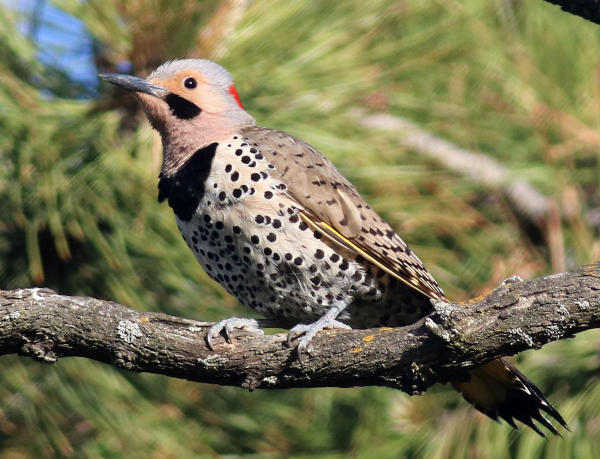
Yellow-shafted Northern Flicker by Paul Konrad

Red-shafted Northern Flicker by Scott Shuey
|
Northern Flickers emit a loud wonderful call of the wild and are the most common and widespread woodpeckers in North America. Flickers are specialized woodpeckers that are much more ground-oriented than other species, especially because they feed on ants. Flickers eat more ants than any other American birds. Like other woodpeckers, flickers are important cavity-creators for the 88 species of cavity-nesting birds, plus cavity-roosting birds and other small animals.
Like other woodpeckers, flickers have an exceptionally long tongue that wraps around the back and top of their skull that can be extended two inches past the tip of their bill into ant holes. The tip of the tongue has very small barbs to help extracting ants from underground colonies, but even more important is the extremely sticky saliva that covers their tongue.
To help protect their head and neck during “drumming” and excavating, the skull of flickers and other woodpeckers is made of sponge-like bone that is especially thick and spongy at the rear base and frontal bone. This skull structure combined with the near-absence of fluid in the space surrounding the brain help protect woodpeckers when excavating or drumming. Flickers and other woodpeckers share adaptations that include zygodactyl feet that allow them to position two toes forward and two toes backward as they perch, climb or stand, which gives them better balance and grabbing abilities.
One of the most common North American woodpeckers, Northern Flickers are divided into east-west subspecies primarily by the yellow (east and north) or red (west) under-wing and under-tail colors, plus their head colors and markings. Not long ago the Red-shafted and Yellow-shafted subspecies were each given full species status by the American Ornithologists’ Union, but even though there is a small zone of hybridization where the subspecies ranges overlap, they are considered a single species today. Overall, there are eight species of flickers in the Western Hemisphere, while 214 woodpecker species are recognized worldwide.
Yellow-shafted Northern Flickers from Alaska and northern Canada are strongly migratory and are known to migrate eastward, then south with loose flocks migrating southward along the East Coast during fall. Red-shafted Northern Flickers tend to migrate shorter distances southward, as do some interior Yellow-shafted Northern Flickers.
Range: From northern Alaska and northern to Newfoundland south through Mexico. Northern Flickers winter within North America with northern populations migrating during fall and spring.
Habitat: Trees with snags adjacent to open areas with an abundance of ants, including suburban areas.
Mating: Pairs are monogamous and perform loud mating displays with pairs calling, drumming and displaying using wing-flashing and tail-spreading, billing and head-bobbing while facing one another.
Nest Sites: Male and female cooperate in excavating a nesting cavity, usually in a tree snag or pole. Sometimes a nesting cavity is re-used during a second year.
Clutch Size: 5 to 8 white eggs.
Incubation Period: Both female and male share incubation of the egg clutch; nestlings hatch in 11 to 14 days.
Nestling Period: Male and female provide food and care for nestlings.
Fledging: Nestlings fledge in 25 to 28 days. Pairs may nest twice per season in southern portions of the species’ range.
Food: Primarily ants; sometimes other insects, berries or suet.
Conservation Status: The most common and widespread North American woodpecker, although they appear to be declining slowly throughout much of their range.